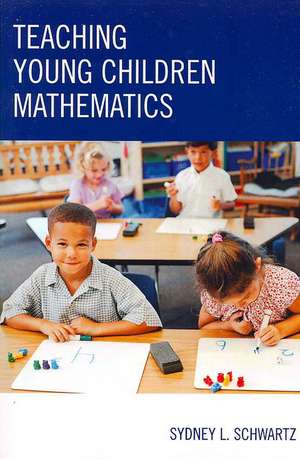Teaching Young Children Mathematics
Autor Sydney L. Schwartzen Limba Engleză Paperback – 6 feb 2008
| Toate formatele și edițiile | Preț | Express |
|---|---|---|
| Paperback (1) | 388.62 lei 6-8 săpt. | |
| Rowman & Littlefield – 6 feb 2008 | 388.62 lei 6-8 săpt. | |
| Hardback (1) | 323.73 lei 6-8 săpt. | |
| Bloomsbury Publishing – 29 sep 2005 | 323.73 lei 6-8 săpt. |
Preț: 388.62 lei
Nou
Puncte Express: 583
Preț estimativ în valută:
74.37€ • 77.55$ • 61.81£
74.37€ • 77.55$ • 61.81£
Carte tipărită la comandă
Livrare economică 20 martie-03 aprilie
Preluare comenzi: 021 569.72.76
Specificații
ISBN-13: 9781578867011
ISBN-10: 1578867010
Pagini: 212
Dimensiuni: 152 x 228 x 17 mm
Greutate: 0.34 kg
Editura: Rowman & Littlefield
ISBN-10: 1578867010
Pagini: 212
Dimensiuni: 152 x 228 x 17 mm
Greutate: 0.34 kg
Editura: Rowman & Littlefield
Notă biografică
Cuprins
Preface: The Challenge of Early Childhood Mathematics EducationThe Educational Challenge: Empowering Young Children to Use MathematicsDesigning Games and Playful Activities: Meaningful Context for Practice and ApplicationHow Young Children Learn about Mathematics: Content-Process ConnectionsHow Children Learn Number Concepts and SkillsHow Children Learn Geometry and MeasurementThe Connection Between Assessment and TeachingHow Adults Can Communicate With Young Children About MathematicsCalendars and Clocks: Tools for Time ManagementScience and Mathematics: Curriculum PartnersSocial Studies and Mathematics: Curriculum PartnersMeaningful Use of Mathematics in Classroom RoutinesPutting It All Together: A Model
Recenzii
Schwartz is well known for her numerous articles on teaching mathematics to young children. She draws on her experiences as an early childhood teacher to give valuable insights into preschoolers' perspectives, interests, and abilities. The chapters on games and the integration of mathematics with other disciplines and classroom routines are useful to anyone planning for or teaching in an early childhood program. Schwartz views mathematics as important but argues that it should be introduced, used, and practiced in contexts meaningful to the young child. Two chapters attend specifically to mathematical learning, one on number concepts and skills, the other on geometry and measurement. The recommended readings are helpful, but there are important ideas about young children's understanding of numbers, their struggles with tens and ones, and what is known about types of simple word problems that do not appear in the text. While primary teachers will find valuable ideas, both preschool and primary teachers will need other sources to find the range and clarity of mathematical ideas needed..Recommended. Upper-division undergraduates and practitioners.
